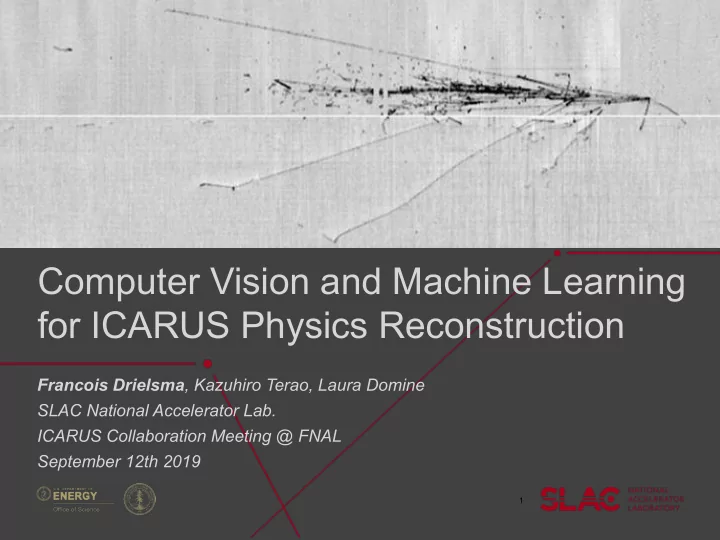

Computer Vision and Machine Learning for ICARUS Physics Reconstruction Francois Drielsma , Kazuhiro Terao, Laura Domine SLAC National Accelerator Lab. ICARUS Collaboration Meeting @ FNAL September 12th 2019 1
Computer Vision and LArTPC Image Data Analysis Development Workflow without Machine Learning 1. Write an algorithm based on physics principles algorithm Neutrino interaction = collection of certain shapes 2
Computer Vision and LArTPC Image Data Analysis Development Workflow without Machine Learning 1. Write an algorithm based on physics principles 2. Run on simulation and data samples 3. Observe failure cases, implement fixes/heuristics 4. Iterate over 2 & 3 till a satisfactory level is achieved 5. Chain multiple algorithms as one algorithm, repeat 2, 3, and 4. algorithm 3 https://arxiv.org/pdf/1808.07269.pdf
Computer Vision and LArTPC Image Data Analysis Development Workflow without Machine Learning 1. Write an algorithm based on physics principles 2. Run on simulation and data samples 3. Observe failure cases, implement fixes/heuristics 4. Iterate over 2 & 3 till a satisfactory level is achieved 5. Chain multiple algorithms as one algorithm, repeat 2, 3, and 4. Machine Learning • “ Learn patterns from data ” - automation of steps 2, 3, and 4 “ algorithm • “ Chain algorithms & optimize ” - step 5 addressed by design • “ Deep Neural Network ” - de-facto standard in computer vision 4
Computer Vision + Machine Learning in Particle Imaging Neutrino Detectors NOvA Neutrino LArTPC particle ID Event Topology e γ μ π NEXT Signal vs. Background MicroBooNE Signal/Backgroun d 5
Computer Vision + Machine Learning in Particle Imaging Neutrino Detectors NOvA Neutrino LArTPC particle ID Event Topology e γ μ π “Whole Image Analysis” … may be the simplest way if it works! NEXT Expect difficulty for highly detailed LArTPC images Signal vs. Background ● Could we know where things fail (and how)? ● Could we enforce physics principles (e.g. key features like vertex, dE/dx, etc.) to be used? MicroBooNE ● … yes, that’s our research! Signal/Backgroun d 6
Computer Vision + Machine Learning for Image “Feature” Extraction Image Context Detection - Identify object location (where) - Identify object class (what) 7
Computer Vision + Machine Learning for Reconstructing Hierarchical Feature Correlations Interpret image context correlations https://cs.stanford.edu/people/karpathy/cvpr2015.pdf 8
ML-based LArTPC Data Reconstruction Big picture ML-based Full Data Reconstruction Chain A hierarchical chain of task-specific algorithms 1. Key points (particle start/end) + pixel feature extraction 2. Vertex finding + particle clustering 3. Particle type + energy/momentum 4. Interaction (“particle flow”) reconstruction 5. PMT-TPC signal “matching” Input Step 1 Step 2 Step 3 p pi e p 9
Computer Vision + Machine Learning for LArTPC Image Data Analysis Example : pixel classification algorithm used in MicroBooNE to identify shower pixels, useful for nue interaction Input : data (MicroBooNE) Output : shower/track separation TERAO, Kazurhiro et al (2018). A Deep Neural Network for Pixel-Level Electromagnetic Particle Identification in the 10 MicroBooNE Liquid Argon Time Projection Chamber, https://arxiv.org/pdf/1808.07269.pdf
Computer Vision + Machine Learning for LArTPC Image Data Analysis Example : removal of mis-reconstructed 3D points Input : reconstructed 3D points Output : mis-reconstructed points removed by Machine Learning
Computer Vision + Machine Learning for LArTPC Image Data Analysis Example : removal of mis-reconstructed 3D points Input : reconstructed 3D points Reference : mis-reconstructed points removed by truth info
Computer Vision + Machine Learning for LArTPC Image Data Analysis Next Goal : point prediction + particle clustering on ICARUS sample ( warning : below is for DUNE-ND) 1.5 m 1.5 m Particle 13
Computer Vision + Machine Learning in ICARUS Plan Overview Goal : maximize physics extraction from ICARUS data Plan : develop a reconstruction chain for physics feature extraction using machine learning algorithms ● So far primarily 3D pattern recognition (3D points input) ○ Can use other algorithms (WireCell, Pandora, etc.) ● Starting on 2D image analysis (identical algorithms) ○ Michel reconstruction (next talk) + data vs. simulation discrepancy study/mitigation during commissioning Team : anyone is welcome , SLAC team consists of 6-8 people supported by three DOE grants dedicated for machine learning for LArTPC experiments (SBN/DUNE) + CSU faculty and graduate students (3-5) ● Further collaborations (ATLAS/LSST/outside HEP) for uncertainty estimates/optimization + distributed computing on High Performance Computing facilities 14
Backup slides
Computer Vision + Machine Learning for Pixel-wise identification Segmentation segmentation : pixel-wise identification performance in simulations Particle Type Pixel-wise accuracy Heavy ionizing particle 99.3% MIP 98.1% Shower 99.2% Delta rays 97.2% Michel electrons 95.7% Total 99.1% DOMINE, Laura, & TERAO, Kazuhiro. (2019). Scalable Deep Neural Networks for Sparse, Locally Dense Liquid Argon Time Projection Chamber Data, https://arxiv.org/abs/1903.05663
Computer Vision + Machine Learning for Point proposal Point proposal : performance of identifying end points of tracks and start points of showers in simulations DOMINE, Laura, & TERAO, Kazuhiro. (2018). Applying Deep Neural Network Techniques for LArTPC Data Reconstruction. Zenodo. http://doi.org/10.5281/zenodo.1300713
Recommend
More recommend